Alain Cuny as
Steiner in
La Dolce Vita (1960)
by Ingrid Wenzler
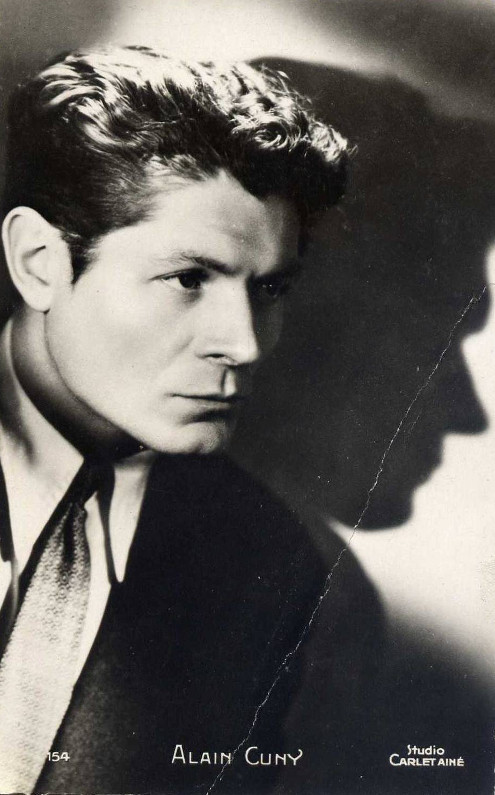 I don’t remember when I first saw Federico Fellini’s La Dolce Vita. I know it would have been some time in the year after graduating from college. I was as new to the world of film as I was to the intricacies of New York transit, always getting lost in the dark and the dim of underground places. I had moved to Brooklyn, was living with a film major, meeting friends of hers and playing soccer with a team whose roster looked like a movie’s closing credits. There was a would-be director, a producer in the making, an editor, a sound technician and an electrician.
I don’t remember when I first saw Federico Fellini’s La Dolce Vita. I know it would have been some time in the year after graduating from college. I was as new to the world of film as I was to the intricacies of New York transit, always getting lost in the dark and the dim of underground places. I had moved to Brooklyn, was living with a film major, meeting friends of hers and playing soccer with a team whose roster looked like a movie’s closing credits. There was a would-be director, a producer in the making, an editor, a sound technician and an electrician.
We claimed not an actual field for ourselves but a stretch of one, calling our stretch “the Dirt,” because that’s what it was, dust and dirt. Most nights, I was one of two girls who showed up, but as I ran around, opening myself to the ball, I was only rarely reminded of that fact. I was marked in the same way, taken seriously as I circled the goal. After playing, covered in sweat and dust, we would slip into sandals and make our way to some local bar, where we would talk movies or, at least, gossip about Arsenal. Among these boys, I felt admired but in a distant way. I imagine they saw me as more an Ingrid Bergman than a Marilyn Monroe, though they never said as much. Whatever they thought, they treated me to beers but left me to drink my pilsners in peace.
Jordan was interested in Errol Morris. Ryan liked Herzog. John, who was shorter than the others, quicker and more sensitive, recommended Ivan’s Childhood in earnest. A natural critic and a casual one, John spoke of the contrast between Ivan’s inner world and the war-torn landscape. A few more beers in, he started to ask me about that troublesome kiss in the white birch grove, the movie’s most famous scene, but something made him stop. Maybe he didn’t want to single me out. Maybe my eyes said, Please don’t.
With my roommate, I went to see movies at Film Forum, IFC, Village East, Anthology. We worked our way into small screenings and festivals, visited MoMA’s theaters. That year was a special time for me in many ways. I encountered new movies and new directors at every turn and, as a young writer, I finally had friends who shared my interest in stories and some of my references, La Dolce Vita among them.
Fellini shot the movie in Rome in 1959. Marcello, a gossip columnist played by Marcello Mastroianni, is the movie’s hero. Ebert perfectly captures Marcello’s character, when he comments in a 1997 review that, “The two Marcellos—character and actor—flowed together into a handsome, weary, desperate man, who dreams of someday doing something good, but is trapped in a life of empty nights and lonely dawns.” Marcello, Fellini’s character, is certainly weary and handsome. He dreams of more serious work, and does seem trapped in the movie’s many nights and dawns. As he hunts down spectatorial stories for his column, he takes us with him. We drive to the outskirts of Rome to cover a fake sighting of the Madonna. We visit nightclubs and attend extravagant parties. Every character and color seems stranger and brighter than the last. This was how I saw my early days in Brooklyn or, at least, it was how I wanted to see them.
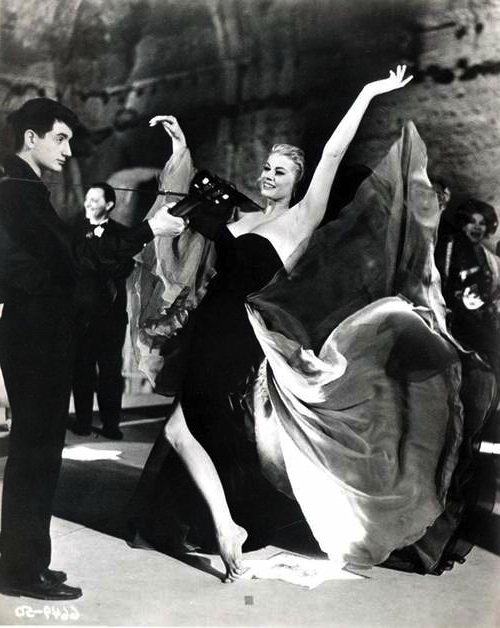 In one of the movie’s famous early scenes, we meet a visiting movie star, Sylvia from America (Anita Ekberg). With Silvia, we climb to the top of St. Peter’s Basilica only to encounter her later, in an open-air nightclub. As she slow dances with Marcello, coming closer to Marilyn Monroe than most impersonators, he whispers to her in Italian, a language she clearly doesn’t understand: “You’re everything, Sylvia. You know that? You are everything—everything. The first woman on the first day of creation. You’re mother, sister, lover, friend, angel, devil, earth, home. That’s what you are: home.” For a moment, this woman, who is child, mother, sister, lover, friend, angel, devil and innocent, in her way, seems to be Marcello’s answer but, as it is throughout the movie, the scene is quick to change.
In one of the movie’s famous early scenes, we meet a visiting movie star, Sylvia from America (Anita Ekberg). With Silvia, we climb to the top of St. Peter’s Basilica only to encounter her later, in an open-air nightclub. As she slow dances with Marcello, coming closer to Marilyn Monroe than most impersonators, he whispers to her in Italian, a language she clearly doesn’t understand: “You’re everything, Sylvia. You know that? You are everything—everything. The first woman on the first day of creation. You’re mother, sister, lover, friend, angel, devil, earth, home. That’s what you are: home.” For a moment, this woman, who is child, mother, sister, lover, friend, angel, devil and innocent, in her way, seems to be Marcello’s answer but, as it is throughout the movie, the scene is quick to change.
Fellow actor, Frankie Stout (Alain Dijon), arrives in a fake beard, and the party begins to turn. He exclaims, “Sylvia.” His hands make a megaphone round his mouth. Sylvia calls back, “Frankie, hi!” As he makes his way over to the band, woo-wooing and beating his mouth like a boy playing Cowboys and Indians, he requests another song, this one more up-tempo. In the beard, worn for a movie he’s been filming, Stout looks like a caricature of a faun, C.S. Lewis’s Tumnus, or anybody’s devil. A natural at this part, he contorts his face, licks his lips. 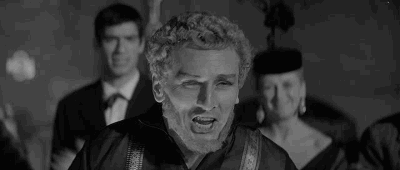 Sylvia’s shoes come off. He lifts her into the air. Moments later, the roused nightclub audience begins to chant, “Rock and Roll! Rock and Roll!”
Sylvia’s shoes come off. He lifts her into the air. Moments later, the roused nightclub audience begins to chant, “Rock and Roll! Rock and Roll!”
Through this early scene, and many others, we begin to understand the movie’s questions concerning the sacred and the profane. Do we ever encounter either in pure form? Isn’t there some good in the bad, some bad in the good? I was aware of these questions on first viewing, but the movie’s parties seemed wonderful, exotic and rapturous and, being young myself and in Brooklyn, Marcello’s nights struck me as strange and familiar in turns. Sure, Marcello was in Rome surrounded by actors, aristocrats, intellectuals, and other luminaries, and I was only in Brooklyn, but the point seemed the momentum, the flamboyance and dazzling circus play of night people.
I spent so many nights, in my twenties, closing out bars with friends. We drank and stood around Union Pool’s bonfire (a place so cool it wasn’t). We smoked under colored lights hung up in backyards and raced around the city, flirting and dancing, falling asleep on each other’s shoulders coming home. When I first saw La Dolce Vita, I understood, on some level, that I was living a pale version of Marcello’s life. I was sensitive to his moments of despair and frustration. I understood his search even if I couldn’t quite access it. Aspects of his character were beyond me yet.
In Ebert’s initial review of the movie for the Daily Illini (October 4, 1961), a review he wrote as a college sophomore, he suggests, “...there can be no real award for best actor or actress in the film just as in a sense it does not seem to be a film so much as a simple record of ‘the sweet life.’ The characters, in their midnight parody of happiness, are all strangely anonymous. Only their life, their society, comes through—.” I felt similarly about the characters, with one important exception. The character most impressive to me, my immediate favorite, was Steiner (played by Alain Cuny). A study in contrasts like Sylvia, Steiner is cultured and ready, at the same time, to break free from culture. I couldn’t conceive of his character in Ebert’s terms, as “strangely anonymous,” because his character seemed so complicated and human.
Out with soccer friends one night, I leaned over a patio table and tried my voice. “Have you ever thought about Steiner in La Dolce Vita?” The table talk died down. I felt everyone listening in a new way because I always tried, back then, to make my words count. “Do you remember the party scene, when that recording of thunder plays, how Steiner’s children come into the room and break everything up? After the children leave, Steiner repeats his daughter’s question to the party, ‘Who is the mother of the sun?’” I hesitated at that point, thinking out my words. “I like the kind of attention Steiner pays. I like the kind of character who notices minor beauties, every day treasures like that.” Wondering if I had gone overboard, I looked around for help. The group rushed to my rescue, talking over each other in the effort. Everyone agreed in a hurry. “Steiner’s attention was beautiful.” We carried on drinking, considering other moments in movie, no one daring to mention Steiner’s fate.
~
We first encounter Steiner in an enormous church. Marcello sees him and chases after him. It is, of course, Marcello’s job to notice interesting people and pursue their stories, but Marcello treats Steiner differently from the start. He clearly admires him. “I thought I saw you come in here,” he says, greeting Steiner warmly. “How are you? What are you doing here?” Steiner explains that the church has become “like a second home.” The priests let him play the organ now and again, and Father Franz has found a book he’s been looking for, an old Sanskrit grammar.
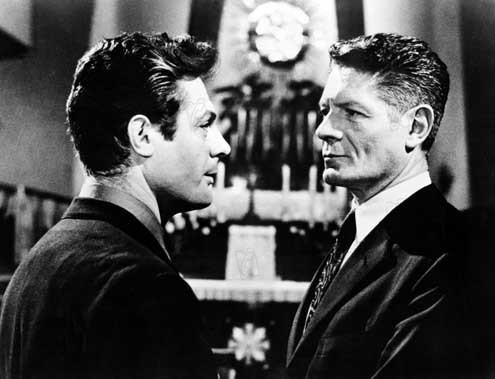 If there’s such a thing as having a distinctly punchable face, Steiner’s must be the opposite. I liked his face and his demeanor before I could explain why. When I first saw the movie (and even immediately afterward), I couldn’t imagine disinterest in him. I couldn’t imagine preferring another character to him. Strolling through the church with Marcello, Steiner asks how Marcello’s book is coming and compliments his most recent magazine article in the same breath: “It was clear and passionate, your best qualities. The ones you insist on trying to hide.” I think of this insight into Marcello’s character as typical of Steiner, a sensitive man, poised and considerate, with the power to express what he observes, as a poet would. It’s important to me, as someone perpetually in a state of figuring out the balance between work and writing, writing and work, that Steiner’s criticism is loving and friendly. It has everything to do with the moment, everything to do with his appreciation of Marcello’s character.
If there’s such a thing as having a distinctly punchable face, Steiner’s must be the opposite. I liked his face and his demeanor before I could explain why. When I first saw the movie (and even immediately afterward), I couldn’t imagine disinterest in him. I couldn’t imagine preferring another character to him. Strolling through the church with Marcello, Steiner asks how Marcello’s book is coming and compliments his most recent magazine article in the same breath: “It was clear and passionate, your best qualities. The ones you insist on trying to hide.” I think of this insight into Marcello’s character as typical of Steiner, a sensitive man, poised and considerate, with the power to express what he observes, as a poet would. It’s important to me, as someone perpetually in a state of figuring out the balance between work and writing, writing and work, that Steiner’s criticism is loving and friendly. It has everything to do with the moment, everything to do with his appreciation of Marcello’s character.
After climbing up to the church’s loft and playing Bach for Marcello, Steiner says of the music, “Sounds we’re no longer used to hearing. Like a mysterious voice from deep within the earth.” The scene is as light and playful as it is revealing. Steiner’s comment demonstrates something of his interest in spirituality, an attraction that we learn has more to do with the mysteries of faith, unusual sounds and ancient grammars, than doctrine and every day practice. As an older viewer (nearly ten years older now), I recognize that some of the movie’s characters treat the Far East as exotic. There’s a faddishness about it. I recognize that some viewers and critics may consider Steiner an imposter, acting out the part of an intellectual, but that’s never been my read. Steiner’s enthusiasm for the unknowable, the so-called mysteries of faith, makes sense to me. I share in this enthusiasm and can relate to turning to spirituality out of something like curiosity. Religious traditions have so much to offer us by way of rituals and rhythms, stories and parables. If Steiner finds a measure of beauty in the sounds of the organ, isn’t that worth something? Isn’t finding the magic that lives in religious tradition some of the point? I wonder, as I think this through, if my appreciation for Steiner has to do with his ability to bring viewers closer to life’s riches.
One of the movie’s most magical moments takes place in Steiner’s apartment. The occasion is a party hosted by Steiner and his wife, recalling the salons of Gertrude Stein, and perhaps the surrealists. We have an artist, a writer, a singer, a poet. At one point, a young man (Desmond O’Grady) records Steiner conversing with the poet and self-ascribed “alcoholic oracle,” Iris (Iris Tree). The young man playfully refers to this recording as “Dialogue between feminine wisdom and masculine uncertainty.” Iris pronounces Steiner “a gothic spire,” claiming he’s so tall “he can’t hear any more voices up there.” No, Steiner says, “If you could see my real height, you’ll [sic] see I’m not much taller than this.” He leaves a couple of inches between his fingers.
When that recording comes to an end, another begins. Steiner quickly gets to his feet and moves to shut it off. It’s one of his nature recordings. The group, of course, insists on listening. We hear waves crashing, birds calling. The furious winds of a storm. Steiner’s relationship to these recordings remains unclear, as do his reasons for making them. Are these samplings of “sounds we’re no longer used to hearing”? Do they bring Steiner closer to nature or farther from it? Apparently the co-screenwriter credited with the creation of Steiner, Tullio Pinelli, intended the sounds of nature to be distancing. Whatever his intentions, I would argue that the sounds have just the opposite effect, carrying each listener to a more beautiful place.
Eventually his children, a boy and a girl, interrupt the scene by entering the room. His wife (Renée Longarini) collects the boy in her arms and suggests that the sound of the storm woke him. Here Steiner offers additional insight into character, this time his children’s different temperaments. In a tone of voice that expresses genuine warmth, fondness and fatherly pride, he reflects, “If the boy hears something interesting, first he thinks about it with a serious little face, and then he laughs cheerfully. If you give him a flower, first he examines it, and then he laughs because he understands it’s beautiful.” Returning to his guests, he continues, “The girl loves combinations of words. A new phrase enchants her. Sometimes she invents them herself. I’ve written down a few. For example... ‘Who is the mother of the sun?’ It’s really beautiful. The words of a poet.”
A few minutes later, Steiner steps out onto his balcony to smoke and get some air. Marcello follows. In awe of Steiner’s life—his family, his friends and the art that surrounds him—Marcello asks if he can visit more. Steiner assures Marcello but resists giving him the wrong impression. In his longest speech, he confides in Marcello, letting us in on his deepest doubts:
The answer isn’t being locked up at home. Don’t do what I’ve done. I’m too serious to be an amateur but not serious enough to be a professional. The most miserable life is better, believe me, than an existence protected by a society where everything’s organized and planned for and perfect. I can only be a friend so I can’t give you any advice. Sometimes at night... the darkness and silence weigh on me. It’s peace that frightens me. I fear peace more than anything else. It seems to me it’s just a façade with hell hiding behind it. I think of what my children will see in the future. ‘It will be a wonderful world,’ they say. But how, when a phone call can end it all? One should live beyond passion and emotion, in the harmony found in perfect works of art, in that enchanted order. We should learn to love one another, to live outside of time, detached.
This is Fellini preparing us for what I consider the movie’s central tragedy, that terrible later sequence when we learn that Steiner has killed his children and taken his own life.
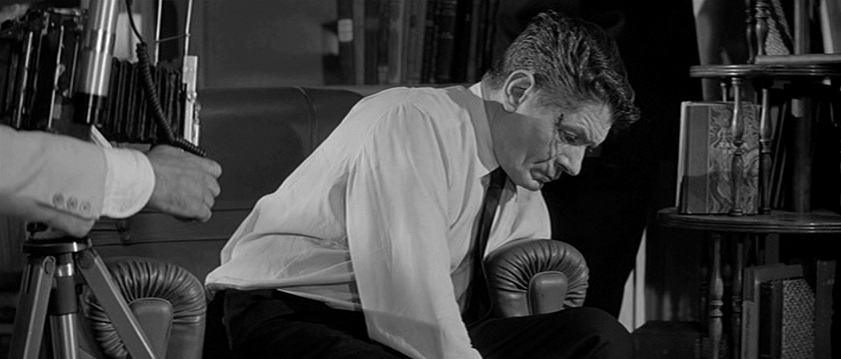
Roger Ebert’s 1997 review claims that, in finding out what Steiner’s done, “Marcello discovers that Steiner's serenity was made from a tissue of lies.” I understand Ebert’s logic here, but, it seems to me that equating Steiner’s serenity with the kinds of façades he takes issue with—domestic life and a society “where everything’s organized and planned for and perfect”—fails to give credit where credit is due. Standing with Marcello on his balcony, Steiner questions a fascist society “where everything’s organized and planned for and perfect” but doesn’t seem to question a more elusive, extensible order. He claims that “one should live beyond passion and emotion, in the harmony found in perfect works of art, in that enchanted order; we should learn to love one another, to live outside of time, detached,” but his tone is no longer wistful, as it was describing his children earlier. It seems to me that Steiner killing his children and taking his own life points not to “a tissue of lies,” not to a careful manipulation of Marcello, but to a complicated understanding of the present moment and his role in it. Here is a man deeply troubled by his country’s politics.
I have to admit, at twenty-three, I wasn’t sure what to do with Steiner’s crimes, where to put them. I felt in my stomach that what he did was violent, terrible, but I trusted that his intentions weren’t as bad as their result.
Having seen La Dolce Vita many more times over the years, I’ve come to appreciate new characters, Steiner’s daughter, the girl from the café where Marcello goes to work on his novel (Valeria Ciangottini), Maddalena (Anouk Aimée) with her self-possession and secrets. I appreciate Marcello’s character more than I did first time around. I know something about jobs taking you away from the work you most want to be doing. I know something about completing one assignment only to have another quickly take its place. I don’t stay out quite so late. Still Steiner remains my complicated favorite. Nine years and more schooling have taught me to look for evidence to better understand that feeling I get in my stomach, but the feeling remains. I can’t quite reconcile my affection for Steiner with his terrible deeds. I can’t tell you what to think of him, where to put his crimes. I don’t have the answers. I have only feelings.
Now, I mean right now, as I type this even, I feel Marcello’s hurt and anger at learning of Steiner’s murders and suicide as if they were my own. Where Marcello, frustrated and angry, encourages a violent orgy at a house party, I refuse to excuse Steiner’s violence and refuse, at the same time, to dismiss his character’s better qualities. Misguided as his violence is, I hear the genuine concern in Steiner’s voice when he says to Marcello, “I think of what my children will see in the future.” I listen to his nature recordings. I hear him taking delight in his children’s different temperaments. I think of Mussolini’s Italy, and I want to break the world that broke Steiner, not the other way around.
 Ingrid Wenzler studied Creative Writing as an undergraduate at Connecticut College and later earned an MFA from University of Arizona. She is currently at work on a collection of stories unified by thematic concerns and has work published in Cleaver Magazine and Fjords Review. Her favorite season is winter and she was voted Best Female Athlete in her graduating high school class, thanks to her gym teacher, Chap.
Ingrid Wenzler studied Creative Writing as an undergraduate at Connecticut College and later earned an MFA from University of Arizona. She is currently at work on a collection of stories unified by thematic concerns and has work published in Cleaver Magazine and Fjords Review. Her favorite season is winter and she was voted Best Female Athlete in her graduating high school class, thanks to her gym teacher, Chap.
~